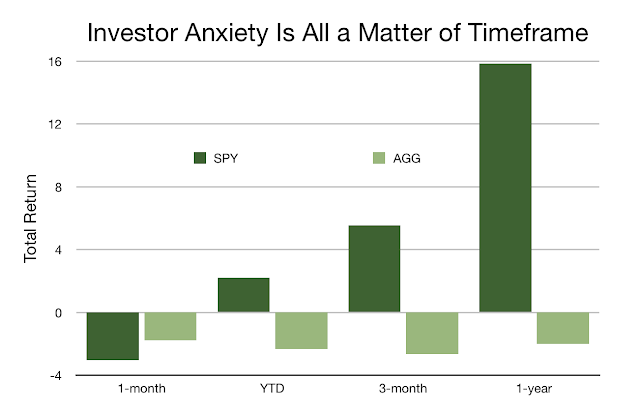Category: Uncategorized
Sector Differences Increased During Month – Rotation to Bonds from Equities
2018 has surprised many investors with a change in focus from economic growth and increased earnings from tax cuts to an emphasis on volatility repricing. Most equity factor and sector styles generated negative returns for the first quarter with the only exception being emerging markets and growth. The only positive price-based signals are within the growth sector.

Portfolio Trust in Mean Reversion Not Momentum – The Contradiction of Investing in Trend-Followers
Most trend-follower will say that they are “non-predictive”. While I think this is true in the sense they do not form forecasts or expectations, trend-following is also based on the prediction that the price direction through some set of price weighting from yesterdays and today will continue into tomorrow. Trend-followers do not try and forecast expected returns rather they extract signals from past data under the assumption that price moves will have memory of at least direction. These managers find trends across a large diverse set of markets and then invest long or short based on these trends. If the markets are moving higher, they are a buyers, and if price move lower they are sellers. Buy high under the assumption that prices will move higher and sell low under the view that prices will move lower.

Stock-Bond Correlation – An Inflation Regime Change Will Push It Higher
A recurring global macro theme has been how investors should think about stock bond correlation. The negative correlation between stocks and bonds has been the single best diversification provider for any portfolio. There are very few alternative investments that have offered the same amount of diversification and provided a significant amount of alpha. This simple diversification is why variations on the 60/40 stock/bond portfolio mix have been such winners since the Financial Crisis. But times change, or more specifically, regimes change.

Expressing Trend Bets Through Futures or Option – The Problem of More Moving Parts
The choice between using futures versus employing options for a trend-following program is worth reviewing after the recent market events. Would trend-followers who used options have done better than those who expressed their directional bets with futures? The key to this answer is whether the trend-follower had a view on volatility.

Quants and Uncertainty – Post-February Thinking
As far as the laws of mathematics refer to reality, they are not certain; and as far as they are certain, they do not refer to reality. -Albert Einstein

Correlation Up – A Beta Not Alpha World For Now
We follow the dispersion, volatility and correlation indices generated by Standard & Poor’s which show intra-index stock behavior over time. When the correlation across stocks within in an index is high, there is a clear sign that the market is facing a macro shock. Performance should be biased toward beta risks. Fund returns will be driven by their beta exposure and timing skill not by their stock-picking skill. When correlation is low across stocks within an index, we can say it is a stock picker’s environment because skill-based traders will be rewarded for exploiting differentiation across firms. This lower correlation will generate more dispersion in returns if there is additional volatility.

Preqin Investor Survey – What Are The Demands For Hedge Funds?
The recently released Preqin Investor Outlook, Alternative Assets, H1 2018 describes the demanding environment for hedge funds. Investors do not believe hedge fund are meeting their expectations, allocations may be smaller, flows may be reduced, and there is a desire for better alignment of interests. Of course, there is also the desire for more performance. To address these issues hedge funds will have to change.

Pension Asset Allocations – Filled With Alternatives And Not Beta (Willis Towers Watson Survey)
The Willis Towers Watson annual survey provides a wealth of information on global pensions and their asset allocations. Pension asset allocations around the world continue to show a move away from the simple equity and bond betas. The current survey shows only 75% of allocations are between equities, bonds, and cash with equities only given an allocation of less than 50%. These allocation numbers, however, show an increasing exposure to global equities and bonds. The other basket, representing the remaining 25%, includes real state and alternatives which can include a wide range of investment products. Pensions continue to move out of equity and bonds for alpha capital appreciation and income. The US equity allocation is down 10% since 2007 (60% to 50%) while the other category is up 10% from 18% to 28% over the same period.
A Financial Shock And Change In The Market Environment – Not Good For Any Investor
There is little protection for investors when there is a price revaluation from a volatility shock. All equities styles declined in February. All equity sectors generated negative returns. Country equity returns were negative and bonds offered no protection. Correlations all moved higher in February although there are some interesting limited opportunities. A comparison of momentum from the prior month and three-month period show the strength of the reversals. Prices fell below short, medium and long-term trends except for few outliers.

Trends In Markets – Mixed Signals Suggest A Period Of Transition
A review of the trends that current exist across market sectors suggest that there is significant noise about directions and fundamental changes from last month. The equity bounce post the volatility shock seems to have played out and now new information such as “trade wars” seems to be defining new trends. Bonds seem to be moving back to the core negative correlation with equities. The dollar sell-off also seems to have paused except for traditional safe asset currencies. Metals are now trending down but commodities are responding to a weather shock. While there may be profitable opportunities later this month, current signals are mixed.

Hedge Fund Performance Sank With Equity Beta Decline
Hedge funds as measured by the HFR indices suffered with the overall market decline with only RV strategies being able to take advantage of the higher volatility environment. In general, the equity hedge fund declines were consistent with their longer-term betas (approximately .3 to .6). The outliers for the month were the event driven, special situations, macro and systematic CTAs indices. The year-to-date returns show significant dispersion with equity hedge fund indices generally positive while special situations, systematic CTAs, and event driven indices falling between -2.50 and -3.75 percent.

February Performance – Ouch! So Let’s Put In Context
February was a bad month for investment performance. All of the major ETF indices we normally follow were negative. Diversification was an elusive concept and reinforced the key portfolio allocation risks of rising correlation. There is no positive spin with these numbers other than less risky assets like bonds fell less than more risky assets, although year to date numbers show that bonds have not been a safe haven. There are a few takeaways from the month:

Investor Anxiety Is All a Matter of Timeframe
How would you feel about your investment portfolio if you went to sleep at the beginning of the year and woke-up on Friday? What if you stuck your portfolio in a drawer and pulled it out after three months or a year to look at performance? My guess you would say you were happy and comfortable with your investment decisions, yet there has been a lot of investor anxiety this month.